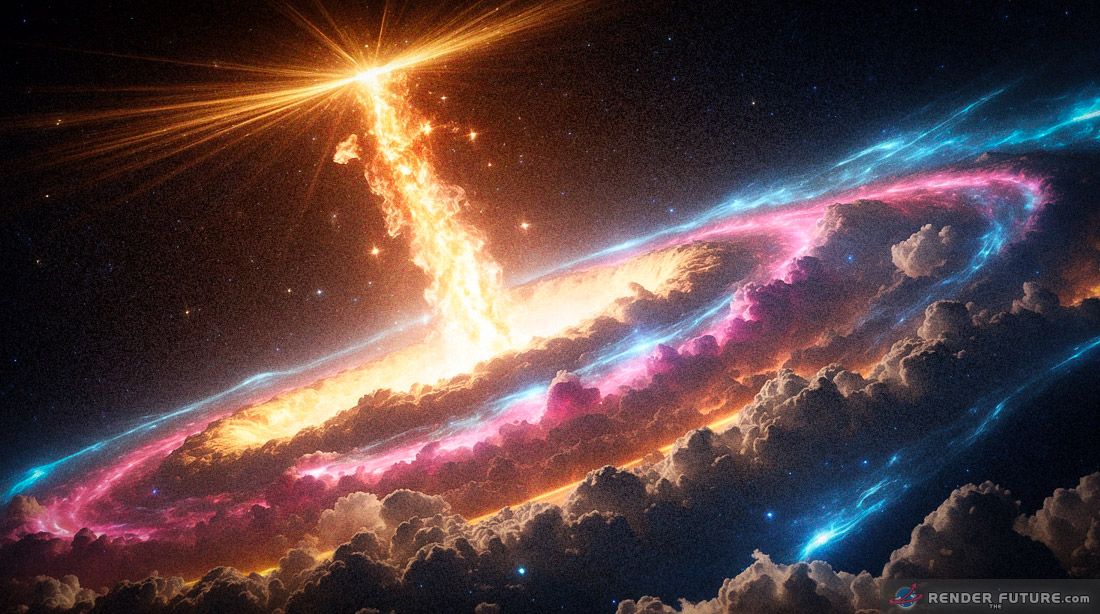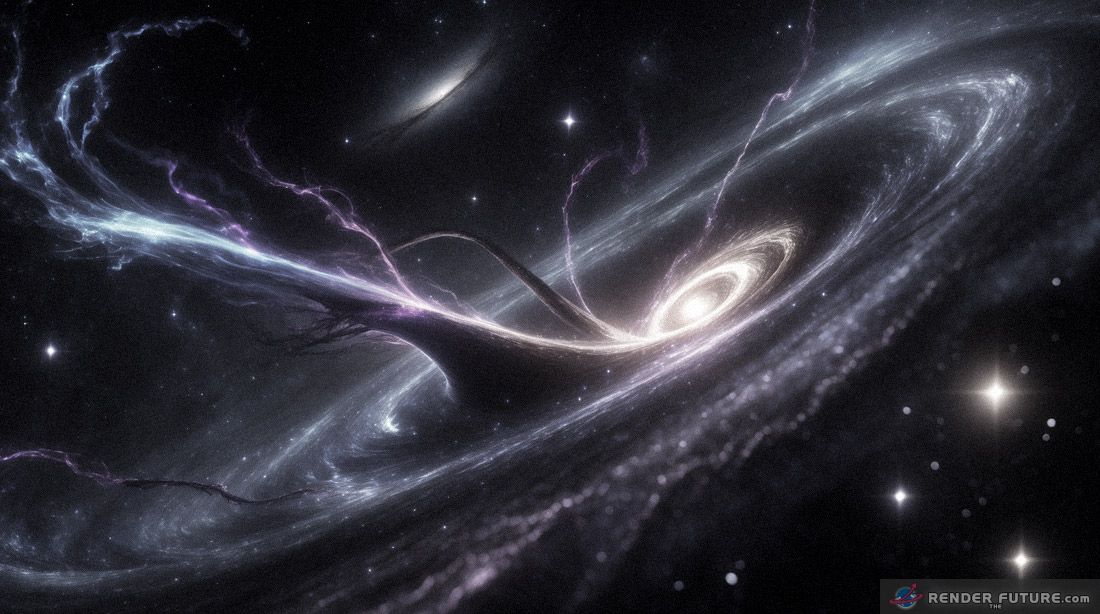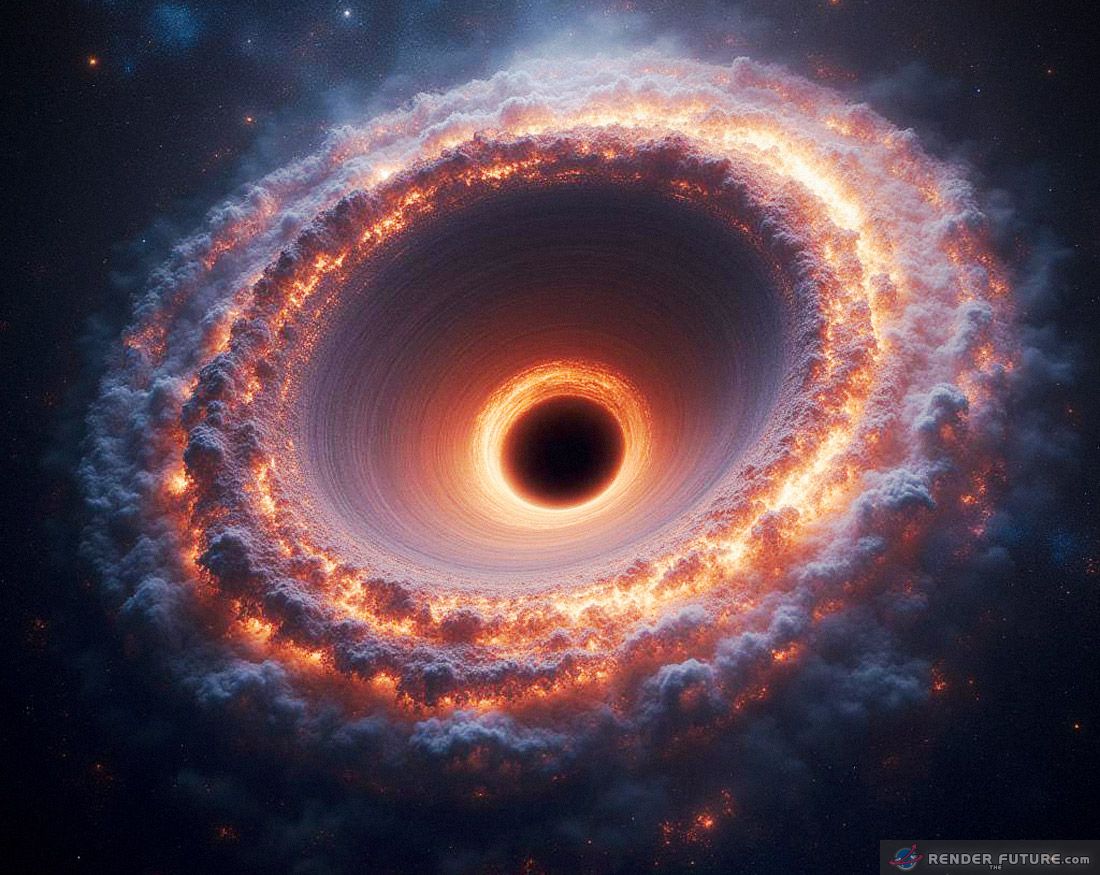Supermassive Black Holes Firing Cosmic BulletsGalactic Winds that are Reshaping the Future of Universe
A Cosmic Revelation: Black Holes Shape the Fate of Galaxies
Just visualize for a minute a force so powerful that it can fling matter across space at nearly a third the speed of light. Now, imagine that force isn’t a rare cosmic anomaly — it’s lurking at the heart of nearly every galaxy, including our own. New groundbreaking observations confirm that supermassive black holes (SMBHs) don’t just sit idly at galactic centers — they blast out winds with unimaginable energy, reshaping entire galaxies in the process.

For decades, scientists suspected that these cosmic giants influenced their surroundings, but the latest data from the X-Ray Imaging and Spectroscopy Mission (XRISM) has shattered expectations.
The quasar PDS 456, a beacon of extreme energy, revealed winds so fierce they defy existing physics models. These aren’t gentle breezes — they’re million-clump hurricanes, ejecting up to 300 times the Sun’s mass every year at 20-30% the speed of light.
 Why This Discovery Changes Everything
Why This Discovery Changes Everything
1. Black Holes Are Galactic Architects
The new findings suggest that SMBHs don’t just consume matter — they expel it with enough force to alter star formation, gas distribution, and even a galaxy’s evolution. The kinetic energy of these winds exceeds the Eddington limit, a theoretical maximum for radiation pressure. This means black holes can unleash more power than we thought possible, fundamentally reshaping their host galaxies.
2. A Million Clumps of Destruction
Previous X-ray telescopes lacked the precision to see the fine details of these outflows. But XRISM’s high-resolution spectrometer, Resolve, detected five distinct wind components, revealing an incredibly clumpy, chaotic structure. Instead of a smooth stream, these winds consist of up to a million dense knots of matter, each hurling through space like cosmic shrapnel.
3. The Mystery of Missing Galactic Winds
Strangely, these ultra-powerful winds don’t always translate to galaxy-wide effects. The energy and momentum don’t efficiently transfer to larger scales, meaning only 10% of quasars might experience this extreme activity. This raises a critical question: What stops these winds from fully reshaping galaxies? The answer may lie in the clumpy nature of both the winds and the interstellar medium, which could absorb or scatter the energy before it spreads.
Could Earth Be Affected by These Cosmic Forces?
 At first glance, the violent winds from supermassive black holes seem like a distant spectacle — something happening billions of light-years away. But the truth is, these cosmic forces will have long-term implications for our own galaxy, and by extension, Earth. While our planet won’t face an immediate apocalypse from these high-speed outflows, the broader influence of black hole activity on galactic evolution means that, over billions of years, even the Milky Way could be transformed. If Sagittarius A*, the black hole at our galaxy’s center, were to awaken and unleash similar winds, it could disrupt the delicate balance of gas and star formation, altering the future of our cosmic neighborhood.
At first glance, the violent winds from supermassive black holes seem like a distant spectacle — something happening billions of light-years away. But the truth is, these cosmic forces will have long-term implications for our own galaxy, and by extension, Earth. While our planet won’t face an immediate apocalypse from these high-speed outflows, the broader influence of black hole activity on galactic evolution means that, over billions of years, even the Milky Way could be transformed. If Sagittarius A*, the black hole at our galaxy’s center, were to awaken and unleash similar winds, it could disrupt the delicate balance of gas and star formation, altering the future of our cosmic neighborhood.
The most immediate concern isn’t destruction — it’s the potential reshaping of star formation.
If powerful black hole winds sweep through the Milky Way, they could push away the gas clouds needed to birth new stars. Over eons, this might lead to a “starved” galaxy where fewer stars are born, dimming the night sky for any future civilizations. Even more intriguing is the possibility that past outbursts from Sagittarius A* may have already influenced Earth’s history. Some theories suggest that ancient gamma-ray bursts or cosmic rays from black hole activity could have triggered mass extinctions — though this remains speculative.
So, what does this mean for humanity’s future?
While we won’t see these changes in our lifetimes, understanding black hole winds helps scientists predict the long-term fate of the Milky Way. If we ever hope to travel beyond our solar system or colonize other star systems, knowing how galaxies evolve — and how black holes drive that evolution — will be crucial. Missions like the upcoming Athena X-ray observatory will help us monitor Sagittarius A* for signs of activity, ensuring that we’re prepared for even the most distant cosmic threats. For now, Earth is safe, but the universe is far more dynamic — and unpredictable — than we once thought.
What This Means for Humanity
Could Our Milky Way Be Next?
Our galaxy hosts its own supermassive black hole, Sagittarius A*. While currently quiet, past activity suggests it, too, could have unleashed similar winds. If reactivated, such an event might disrupt star formation, eject gas, and alter the galactic structure — though not on human timescales. Still, understanding these mechanics helps us predict the future of our cosmic neighborhood.
The Future of Space Exploration
 This groundbreaking discovery underscores the need for better X-ray telescopes with even higher resolution. Missions like Athena (Advanced Telescope for High-ENergy Astrophysics) could soon provide deeper insights. Meanwhile, astrophysicists must revisit existing models, as current theories fail to explain the extreme power and clumpiness of these winds.
This groundbreaking discovery underscores the need for better X-ray telescopes with even higher resolution. Missions like Athena (Advanced Telescope for High-ENergy Astrophysics) could soon provide deeper insights. Meanwhile, astrophysicists must revisit existing models, as current theories fail to explain the extreme power and clumpiness of these winds.
The Next Big Questions
- How do these winds influence star birth and death?
- Could past black hole outbursts explain unexplained galactic features?
- Will we find even faster outflows in other quasars?
But here’s the real kicker — what if these black hole winds aren’t just destructive, but creative?
Could they be carving out pockets of space where new, bizarre forms of star formation emerge? Some scientists suspect these extreme outflows might actually trigger star birth in their wake, like a cosmic domino effect. Imagine: a black hole’s fury indirectly sparking the birth of future solar systems. That would mean supermassive black holes aren’t just monsters — they’re accidental architects of new worlds.
And then there’s the elephant in the universe
 How many other black holes are doing this right now? With XRISM and future telescopes, we’re about to go hunting for more of these cosmic tempests. If we find them, it could rewrite our understanding of how galaxies live and die. One thing’s for sure — black holes have been keeping secrets, and they’re only just starting to whisper them to us. The next decade of astronomy? Buckle up. It’s going to be a wild ride.
How many other black holes are doing this right now? With XRISM and future telescopes, we’re about to go hunting for more of these cosmic tempests. If we find them, it could rewrite our understanding of how galaxies live and die. One thing’s for sure — black holes have been keeping secrets, and they’re only just starting to whisper them to us. The next decade of astronomy? Buckle up. It’s going to be a wild ride.
One thing is certain: black holes are far more than cosmic vacuum cleaners. They’re dynamic, violent engines, capable of altering the fate of entire galaxies. And with every new discovery, we’re one step closer to unraveling their deepest secrets.

References and Sources
- NASA’s XRISM Mission – The latest findings from the X-ray Imaging and Spectroscopy Mission, revealing unprecedented details about quasar winds.
https://www.nasa.gov/ - Nature Astronomy: Black Hole Winds Study – A peer-reviewed analysis of high-velocity outflows from supermassive black holes.
https://www.nature.com/articles/s41550-024-02223-w - European Space Agency (ESA) – Athena Mission – Upcoming X-ray observatory set to revolutionize our understanding of black hole dynamics.
https://www.cosmos.esa.int/athena










